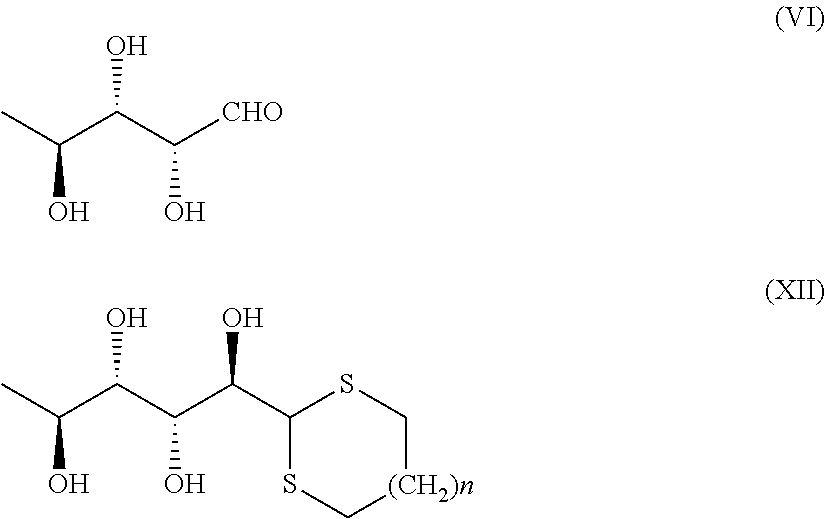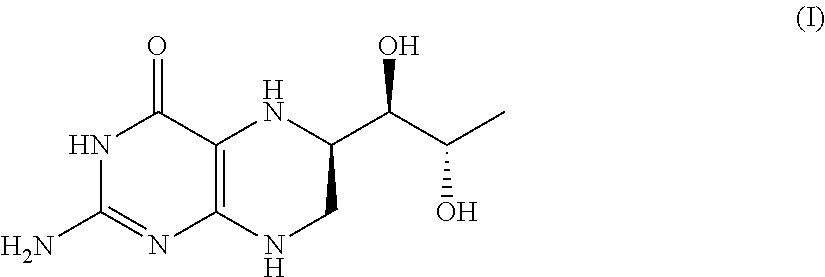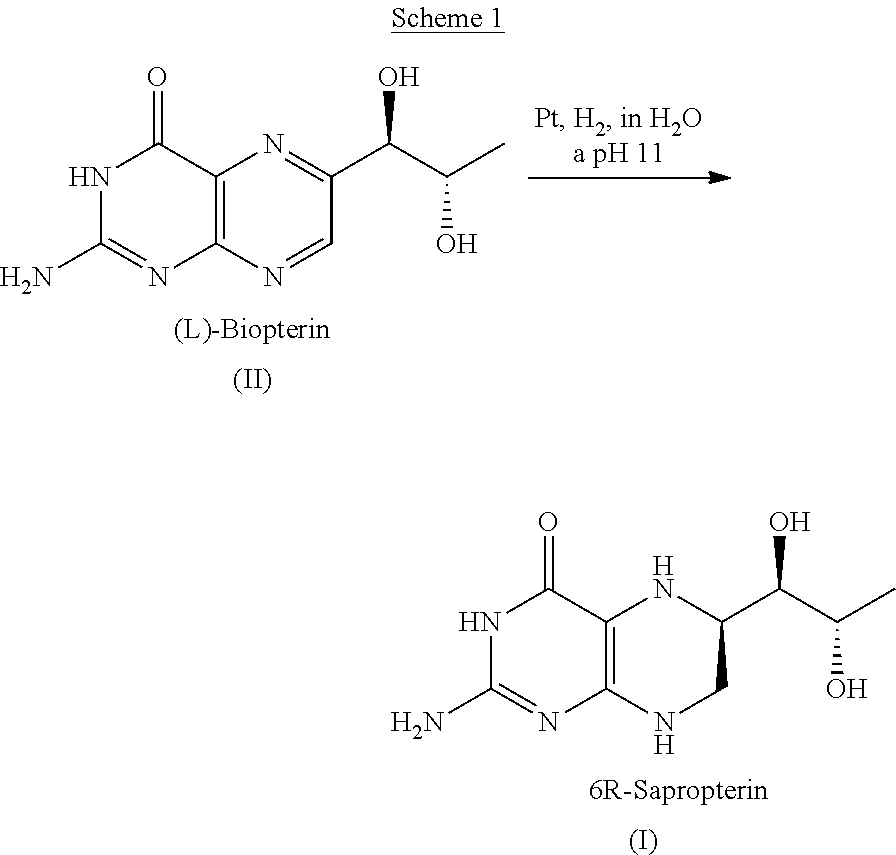Process for the preparation of pteridine derivatives
a technology of pteridine and derivatives, which is applied in the preparation of sugar derivatives, monosaccharides, and organic compounds, etc., can solve the problems of low molecular alkylthiols, the preparation of 5-deoxy-l-arabinose formula, and no longer used on an industrial scal
- Summary
- Abstract
- Description
- Claims
- Application Information
AI Technical Summary
Benefits of technology
Problems solved by technology
Method used
Image
Examples
example 1
Synthesis of (L)-rhamnose 1′,3′-propanedithioacetal (XII; n=1)
[0036]L-Rhamnose monohydrate (168.3 g, 0.92 mol) is added as a solid in portions, under strong stirring, to a mixture of 1,3-propanedithiol (100 g, 0.92 mol) in 500 ml of 37% HCl. The resulting solution is kept under stirring for 12 hours at about 20° C. Already at the first hour, formation of an abundant white precipitate is observed. The suspension is then cooled to 5-10° C. and the acid excess is neutralized with NaOH and 500 ml of ice. The suspension at pH of about 7 is then filtered and the solid is washed with water and 100 ml of isopropanol. The wet solid is dried under vacuum at 40° C. for 16 hours to attain 222 g of product (XII) as an off-white solid in 95% yield.
[0037]C9H18O4S2; MW=254.27; 1H-NMR (300 MHz, DMSO-d6), δ 5.05 (d, 1H, J=5.7 Hz, OH), 4.42 (d, 1H, J=1.2 Hz, H-1), 4.38 (d, 1H, J=5.4 Hz, OH), 4.22 (d, 1H, J=7.2 Hz, OH), 4.00 (d, 1H, J=8.1 Hz, OH), 3.77-3.68 (m, 2H, H-2, H-5), 3.56-3.51 (m, 1H, H-4), 3....
example 2
Synthesis of 1′,3′-propanedisulfonyl (L)-rhamnose (XIII; n=1)
[0038]Sodium tungstate dihydrate (13 g, 0.04 mol) is suspended in a solution obtained by dissolving (L)-rhamnose-1′,3′-propanedithioacetal (XII), (200 g, 0.79 mol) in 1.2 L of glacial acetic acid. The suspension is cooled to about 15° C. and 35% hydrogen peroxide (417 mL, 4,72 mol) is slowly dropped thereinto, keeping the temperature below 40° C. The resulting clear solution is stirred at about 20° C. for 16 hours. The H2O2 excess is then quenched by addition of a sodium thiosulfate concentrated solution. The solvent mixture is then evaporated under reduced pressure to a volume of about 400 mL. The resulting mixture is used directly in the subsequent step, without further purification.
[0039]C9H18O8S2; MW=318.37; 1H-NMR (300 MHz, DMSO-d6), δ 6.24 (d, 1H, J=6.9 Hz, OH), 4.82 (d, 1H, J=7.2 Hz, OH), 4.59-4.54 (m, 2H, H-1, OH), 4.45 (d, 1H, J=5.7 Hz, OH), 4.21 (d, 1H, J=8.4 Hz, H-2), 3.63-3.24 (m, 3H, H-5, H-4, H-3), 2.44-2.14 ...
example 3
Synthesis of 1′,3′-propanedisulfonyl (L)-rhamnose (XIII; n=1)
[0040](L)-Rhamnose-1′,3′-propanedithioacetal (XII) (200 g; 0.738 mol) and sodium tungstate dihydrate (12.2 g, 0.037 mol) are dissolved in glacial acetic acid (991.6 g). Water (48 g) is added to the resulting solution and the reaction mixture is cooled to 10-15° C. 35% hydrogen peroxide (322.5 g; 3.32 mol) is added in at least 4 hours maintaining the temperature at 20-30° C. The reaction mixture is then heated at about 30-35° C. and maintained under stirring for about 3 hours. Isopropanol (416.7 g) is then added. The resulting suspension is maintained under stirring at 30-35° C. for about 5 hours, then cooled to 20-25° C. in at least 5 hours, subsequently cooled to a 5-10° C. in at least 3 hours and maintained under stirring for another hour. The suspension is cooled and then filtered and the resulting solid is washed with isopropanol (314.2 g).
[0041]The product is dried under vacuum at 50° C. for about 24 hours.
[0042]209.9...
PUM
| Property | Measurement | Unit |
|---|---|---|
| Polarity | aaaaa | aaaaa |
Abstract
Description
Claims
Application Information
 Login to View More
Login to View More - R&D
- Intellectual Property
- Life Sciences
- Materials
- Tech Scout
- Unparalleled Data Quality
- Higher Quality Content
- 60% Fewer Hallucinations
Browse by: Latest US Patents, China's latest patents, Technical Efficacy Thesaurus, Application Domain, Technology Topic, Popular Technical Reports.
© 2025 PatSnap. All rights reserved.Legal|Privacy policy|Modern Slavery Act Transparency Statement|Sitemap|About US| Contact US: help@patsnap.com



